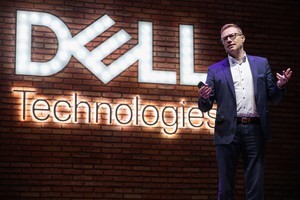We’ve been in the process of transitioning to Industry 4.0 (aka the fourth industrial revolution) ever since the German government coined the term in 2011. It’s proven to be a long and complex journey, and by 2025, the World Economic Forum has estimated that the worldwide impact of Industry 4.0 will reach UK£2.7 trillion(€2.9 trillion) in value. Report by Nigel Moulton, global CTO, Dell Technologies.
Cloud computing and the Internet of Things (IoT) have already had a significant impact on the manufacturing industry, increasing automation and the amount of data generated during the process. The natural next step on the journey will be to enhance those processes using AI and machine learning, to facilitate increasingly sophisticated techniques such as real-time analysis and predictive analytics.
Near real-time insight
Crucial to the success of these transformative processes is edge computing: data processing that takes place on the periphery of the network. Processing data closer to the source reduces the physical distance it must travel, therefore reducing the latency and the implicated cost. And that’s where processing at the edge really comes into its own: the potential for near-real-time insight.
For manufacturing, that insight has the potential to completely transform production lines of all sizes. And that transformation couldn’t come soon enough. Our move towards an on-demand culture, with consumers expecting products to be delivered quicker than ever, means companies need to respond to that demand as efficiently as possible.


And in the future, even fast response won’t be fast enough. We expect to see a significant shift towards anticipatory production, where manufacturers will be able to forecast customer demand, understand how that demand will change over time, and manage resources accordingly. According to a recent Dell Technologies survey, more than 75% of international business leaders expect to be able to do this within the next five years.
Edge computing seamlessly integrates IoT devices into a network infrastructure, and coupled with machine learning (ML) and real-time analytics, can gather, analyse and apply valuable data at speed. This immediacy allows for predictive maintenance and real-time quality control and can also highlight areas that could benefit from increased automation.
OTTO Motors, for example, has developed fully autonomous, self-driving robots, designed for material handling in factories, warehouses and distribution centres. Edge computing allows for the data points needed for the robots to build maps of their environment and move around the space, and for the vast amounts of data collected by the robots themselves.
Widely accessible
What’s particularly exciting, though, is how accessible this technology has become. Previously, it would only be available to multinational corporations with the biggest budgets. OTTO Motors is a mid-sized business making use of its own developments and making them available to enterprises of all sizes.
Freeing up time otherwise spent doing routine or repetitive tasks allows human employees to be at their most productive, and by extension increases the productivity of the business.
The same level of access and innovation has also led smaller businesses to take advantage of 3D printing. 3D printing allows small-batch prototyping and production inconceivable until very recently. The 3D printing market is forecast to account for more than US$20 billion (€17 billion) in spending by 2025 and will only continue to transform further the manufacturing landscape, whatever the size of the business.
Urgent demand
The exceptionally urgent demand for particular products we have witnessed in recent weeks has certainly tested the mettle of the manufacturing industry. And without doubt, increased use of open-source software and data-sharing through edge computing will have played a role in the startling level of agility and innovation many have achieved.
The creation and sharing of prototype tools, technologies, processes and services has facilitated a “cottage industry” of high demand products to emerge. New players in the market (or old players in a new market) have been able to quickly and inexpensively manufacture products and sell them to a global market.
The availability of increasingly sophisticated forms of on-demand, iterative production continues to unleash new opportunities. But what might that mean for the future of manufacturing? For larger companies, the results of this democratisation of innovation are paradoxical.
Low-cost DIY alternatives to traditional product development and manufacturing may well make gains in a market traditionally dominated by industry giants. But I hope that at the same time, those leaner, more agile ways of bringing new products to market will catalyse adoption across the whole industry, large and small businesses alike.
The author is Nigel Moulton, global chief technology officer, Dell Technologies.
About the Author
Nigel Moulton is the global CTO for the Modern Data Centre Business Unit at Dell Technologies, responsible for driving the strategy for cloud, convergence, hyperconvergence and data centre technologies. With more than 25 years’ experience in IT and Telecoms, he is an eloquent authority on IoT, AI and cloud and enjoys sharing his knowledge as a regular keynote speaker at events across Europe, Middle East and Africa (EMEA) and as a spokesperson with both press and the analyst community. Nigel also jointly runs a successful mentoring program, which identifies and prepares talent for more senior roles within the company. Nigel holds a degree in Electrical and Electronic Engineering from Thames Valley University.
Comment on this article below or via Twitter: @IoTNow_OR @jcIoTnow
Leave a Reply